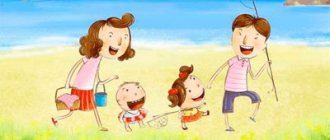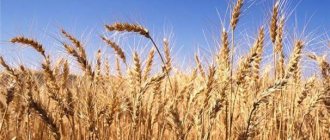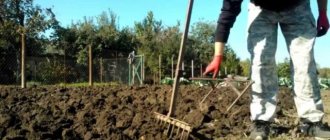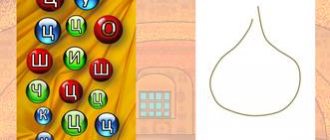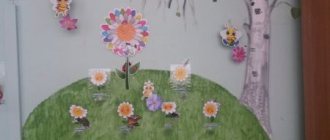Homework on the lexical topic: “Vegetables”
Topic: Vegetables**
Children must learn: when to harvest vegetables; where do vegetables grow? whatever is prepared from them, they contain a lot of vitamins.
Vocabulary
(the child’s vocabulary should include the words): garden, harvest, vegetables, cabbage, carrots, etc.; their color and basic shades, shape (round, oval, triangular); grow, ripen, water, weed, dig, collect, care; mature/immature, ripe/unripe, cook, fry, can, grow, tasty, healthy, sour, sweet, bitter, fresh.
Grammatical structure of speech
1. “Call it affectionately” (formation of nouns in diminutive form). Cucumber – cucumber (tomato, peas, carrots, potatoes, eggplant, peppers, onions, garlic, pumpkin, radishes)
2. “What is there in the garden?” (formation of plural nouns): Cucumber - a lot of cucumbers (peas, tomatoes, carrots, potatoes, radishes, eggplant, peppers, onions, garlic, pumpkin, radishes, zucchini)
3. “What did we eat?” (formation of nouns in the plural of the instrumental case): Tomatoes - we are full of tomatoes Cucumbers - ... Peppers - ... Eggplants - ... Beans - ... Zucchini - ...
4. “Count” (coordination of numerals in gender, number and case): One carrot, two carrots, five carrots. (cucumber, tomato, pumpkin, potato, pepper, radish, garlic, onion, beet, zucchini, eggplant)
5. “Choose a word” (selection of homogeneous adjectives for nouns, 6-8 words): What kind of cucumber? (Green, oval, hard, rough, watery, large, small, tasty). (tomato, potato, zucchini, onion, peas, cabbage, radish)
6. “Make a sentence” (contrasts): The tomato is round, and the carrot... The tomato is red, the carrot... The tomato is soft, and the carrot... The tomato is sour, and the carrot... The tomato has seeds inside, and the carrot... The tomato grows on the ground, and the carrot... (in the ground)
7. “Correct the mistake” (learning relative adjectives; the child must speak the corrected sentences in their entirety): Let’s make mashed potatoes from carrots. Let's prepare beetroot salad from garlic. Let's make carrot juice from onions. Let's make cabbage pie from zucchini. Let's make cucumber salad from tomatoes. Let's make pea soup from radishes. Let's make pumpkin jam from dill.
8. “What will we prepare” (formation of relative adjectives from nouns): From potatoes - mashed potatoes From pumpkin - porridge... From cucumbers - salad... From tomatoes - salad, juice... From carrots - juice... From peas - soup... From eggplants - caviar ... From pepper - seasoning ... From onions - soup ... From garlic - sauce ...
Syllabic structure of the word
(“clap” the words syllable by syllable): PO - MI - DOR, RE-DIS-KA, KA-BA-CHOK, LUK
Connected speech
(writing a story - descriptions according to a diagram, you can use a real vegetable): What is this? What is this vegetable in size, shape, color, taste? Where does it grow? Where can I buy it? What is made from it? Draw some vegetables you love in your notebook.
Author of the material: Didkovskaya Inga Vladimirovna
Also homework on a lexical topic:
Clothes and shoes
Sea, river, aquarium inhabitants
On the topic: methodological developments, presentations and notes
Summary of the final speech therapy lesson in a group for children of the 7th year of life with OHP “School of Dwarfs”.
The abstract was developed within the framework of the thematic ten-day period “My Family” in accordance with the stage of work on the speech (the stage of question-and-answer speech).
A retelling of L. Tolstoy’s story “The Bone.”
Goals: Correctional and educational: 1. Fix the concept of “vowel sounds”, characteristics, designations; correct pronunciation and discrimination of vowel sounds “A”, “U”, “I”, “O”;2. Continue ra.
Goal: - Articulation gymnastics (a set of exercises to develop mobility of the lips and tongue). - Replenishment of vocabulary on the topic: “Vegetables”. - Learn to use verbs depending on the name.
Lesson to consolidate the correct pronunciation of the sound Ш in syllables, words, sentences.
Lesson notes aimed at expanding, clarifying and activating children's vocabulary based on the lexical topic: “Vegetables. Garden". Expanding ideas about the importance of adult work. Develop.
Source
On the topic: methodological developments, presentations and notes
Updating the vocabulary of children in the preparatory school group on the topic: “Native Land.”
Updating the vocabulary of children in the preschool group on the topic: “Where did the bread come from?”
Updating the vocabulary of children in the preparatory school group on the topic: “Space”.
Summary of a speech therapy lesson in the senior group for children with ODD.
The lesson is aimed at strengthening children’s knowledge about parts of the human body: external signs, properties, functions, consolidating rarely used words in children’s active vocabulary: parts of the body: crown, back of the head, vi.
The summary includes; riddles, physical pause and exercises to develop the grammatical structure of speech. There is a presentation included with the summary.
Source
MAGAZINE Preschooler.RF
Cherkashina Irina Vladimirovna Speech therapist teacher, highest category MB preschool educational institution general developmental kindergarten No. 52 “Blue Car” Bataysk, Rostov regionExplanatory note. The lesson notes are a demonstration of the work experience of a speech therapist teacher in the senior group for children with general speech underdevelopment (1st year of study) at the speech center of a preschool educational institution. A frontal lesson on the formation of the lexical and grammatical structure of speech is presented on the topic: “Vegetables. Garden.". For her demonstration, the speech therapist chose a lexical and grammatical lesson, since often by older preschool age it turns out that lexical and grammatical categories in children suffer. At this age, children are still learning to master their native language, and the teacher’s task is to help them with this. Based on the general education program, we know that by the end of the first quarter, children have sufficiently accumulated a vocabulary about autumn and autumn phenomena, this is facilitated by all current pedagogical work. Therefore, the lesson logically entered into the group planning system.
The outline outlines the topic, goals, objectives, plan and progress of the speech therapy session. In a speech therapy session, it is necessary to maintain a clear structure of construction. Each part of the lesson fulfills its specific purpose. In the speech therapist's lesson, the emphasis is on exercise, tasks are selected for the formation of lexical and grammatical categories and the development of coherent speech, which meets the requirements for correctional classes. To achieve the goals of the lesson, all groups of methods are used: visual, verbal, practical, which reflect the same topic and are interrelated. The used set of methods will improve the effectiveness of children’s mastery of lexical and grammatical categories. These methods are revealed using a variety of techniques. From the main techniques used in speech therapy, the following were selected for the lesson: a sample of the teacher’s speech, questions, verbal explanations for actions. In addition, training is based on visual and practical techniques: the use of illustrative and visual material selected in accordance with the age characteristics of children. Didactic games and exercises were widely used. During the lesson, a person-oriented interaction with children is built: listen to the opinion of each child, support their reasoning with a preliminary assessment, thus creating a situation of success for each of them. During the lesson, the following mental processes are activated: auditory attention in working on word formation and composing sentences; logical thinking, visual perception (through cut-out pictures). As a necessary element of speech therapy classes, tasks for the development of fine and gross motor skills (relaxation, finger exercises, practical work with a manual made by a speech therapist) are widely used.
(First year of study) Program content: 1. Activation of passive and active vocabulary on the topic: “Vegetables” 2. Learn to form relative adjectives from nouns. 3. Learn to form the diminutive form of a noun. 4. Develop coherent speech, visual attention, and thinking. 5. Develop coordination of speech with movement, fine motor skills.
Equipment: Pictures depicting vegetables, a plot picture on the theme “Harvesting”, typesetting canvas, dummies of vegetables, a ball; knitted pea pods (with buttons inside) fastened with a zipper, boxes where knitted peas (with buttons sewn on) are mixed with beans.
Progress of the lesson: I Organizational moment. Relaxation. Speech therapist: Today in class we will turn into small vegetable seeds. Sit down. The warm sun warmed the seeds, and the rain poured down. The seeds grew and grew and became plants. Slowly raise your hands, the plants reach for the sun. The sun was very hot and our plants withered. Relax, drop your head, lower your shoulders and torso. The rain began to pour, the plants came to life, reaching for the sun. (Repeat relaxation) Speech therapist: Well done! II Studying a new topic. Game “The Fourth Extra” Speech therapist: Guys, I’ll now show you the pictures, and you tell me what’s extra. Speech therapist: Potatoes, cabbage, radishes, apples. Children: Apple! Speech therapist: Tomato, cucumber, pumpkin, raspberry. Children: Raspberry! Speech therapist: Corn, eggplant, pepper, chanterelles. Children: Chanterelles! Speech therapist: Well done! Did a good job! Why are chanterelles, raspberries, and apples extra? Children: Because these are not vegetables. Speech therapist: Correct! Today we will talk about vegetables! Tell me, where do vegetables grow? Children: In the garden. On the ground and underground. Game "What grows how?" A visual aid “How vegetables grow” is displayed on the board. Speech therapist: Carrots, beets, potatoes, turnips have fruits that grow in the ground, we don’t see them. And the stems are above the ground; Speech therapist: How about cucumber, cabbage, zucchini, where do the fruits grow? Children: Fruits grow on the ground. Speech therapist: Tomatoes, peas, peppers. Eggplants? Children: Fruits grow on branches. Speech therapist: Correct! Well done! III Development of coherent speech. A conversation about vegetables while looking at a picture. The plot picture “Harvesting” is displayed on the typesetting canvas. Speech therapist: Guys, look at the picture carefully. What time of year is shown? Children: Autumn. Speech therapist: What do people do? What vegetables do they pick? Where do they put them? Discussion of the picture. Game "Harvest!" Speech therapist: And now I will show pictures depicting vegetables, and you will make up a sentence about how this vegetable is collected. The speech therapist shows carrots, cabbage, potatoes, radishes, cucumbers, corn, etc. Children: Carrots are pulled out; cabbage is cut; potatoes are dug up, radishes are pulled out, cucumbers are picked, corn is picked, etc. Speech therapist: That's how great we are! The entire harvest was harvested correctly! Now it's time to rest. IV Finger gymnastics. 1. The hostess once came from the market (“we walk” with the index and middle finger on the table). The hostess from the market brought home (we bend our fingers in turn): Potatoes, cabbage, carrots, peas, parsley and beets. Oh! .. (clap your hands) 2. Here the vegetables started a dispute on the table (we clench into fists and unclench our fingers on both hands) Who is better, tastier and more necessary on earth (we bend our fingers in turn): Potato? Cabbage? Carrot? Peas? Parsley or beets? Oh! And with this knife I began to chop (we bend our fingers one by one): Potatoes, cabbage, carrots, peas, parsley and beets. Oh! Potatoes, cabbage, carrots, peas, parsley and beets. Oh!...(clap your hands) And the vegetable soup turned out to be quite good! (we stroke ourselves on the stomach with our palm) V Formation of relative adjectives from nouns. Didactic game “Cook and Vegetables” Speech therapist: Well, we’ve had a rest, and now let’s cook something tasty from the harvest we’ve collected. Speech therapist: Let's make a salad from vegetables. How did the salad turn out? Children: Make a vegetable salad. Speech therapist: Coleslaw? Children: Cabbage. Speech therapist: From beets? Children: Beetroot. Speech therapist: Let's make caviar from zucchini. What kind of caviar do we have? Children: Zucchini. Speech therapist: Let's make mashed potatoes. What kind of puree? Children: Potato. Speech therapist: Let's make juice from tomatoes - tomato juice. Many delicious dishes can be prepared from vegetables. VI Formation of the diminutive form of a noun. Game “Name it kindly” (with a ball). Speech therapist: I will throw you a ball and name a vegetable, you will call this vegetable affectionately and throw the ball back to me. Tomato - tomato; carrot-cucumber; cucumber; pumpkin - pumpkin; Onion - onion; beets - beets; Garlic – garlic; cabbage – cabbage; Peas - peas; potato - potato. Speech therapist: Well done, take your seats. Let's continue playing. VII Development of fine motor skills. Children are given knitted pea pods (with buttons inside) and boxes where knitted peas (with buttons sewn on) are mixed with beans. Speech therapist: Guys, look, all the peas have scattered and mixed with the beans. Let us collect our peas and return them home, firmly attaching them to the pod so that they no longer run away. Speech therapist: Well done! Everyone managed and returned the peas to the houses, and now zip up the pods. VIII Summary. Speech therapist: What did we talk about in class? — What new things have you learned about vegetables? - Guys, I liked the way you worked in class - And now, carefully, listen to the task I will give you: At lunch, be sure to pay attention to what dishes the cook prepared from vegetables.
| Next > |
Preview:
Summary of a speech therapy lesson on the formation of lexical and grammatical connections for children of senior preschool age
Topic: “Vegetables. Fruits. Professions of vegetable grower and gardener."
Strengthen children's knowledge about vegetables and fruits; introduce adults to work in the garden and vegetable garden in the fall; expand and activate the vocabulary on the topic;
form a generalizing concept “Vegetables”, “Fruits”;
Develop word formation and inflection skills:
- learn to select adjectives for nouns;
- form the diminutive form of nouns,
- coordinate numerals with nouns;
-form plural form. numbers of nouns in I.p., R.p.;
Preview:
Summary of GCD in the preparatory school speech therapy group ONR on the lexico-grammatical structure of speech
1. Psychological attitude.
Speech therapist: As usual, at the beginning of the lesson, I tell you: “Hello!”
(Children also say hello).
I close my eyes and count to 3.
After I count to three and open my eyes, you must show what mood you are in.
Hello guys. You recognized me? I brought you autumn gifts.
L.: Thank you, autumn. Stay with us and watch how our children play.
2. Consolidation of the material covered.
Look what is in this basket (vegetables are examined and named); with the first correct answer, the vegetable is placed on the child’s table.
Guys, what other vegetables do you know?
What's in this basket?
Let's name them.
Guys, what other fruits do you know?
Fruits are also distributed to children.
How can you call in one word what I brought (vegetables), (fruits).
3. Introduction of new concepts “garden” and “vegetable garden”
To find out what our activity is called today, we must answer the questions “Where do vegetables and fruits grow?” and then we will find out the topic of our lesson.
Where do you think Autumn got so many vegetables? (children's answers).
Well done, who can name the vegetables we pick? (cucumbers, tomatoes, peppers, etc.).
Which ones do we dig up? (potato).
And which ones do we pull out of the ground? (carrots, beets, radishes, turnips, onions, etc.).
What vegetables do we cut with a knife? (pumpkin, zucchini, cabbage, eggplant).
Okay, where did she pick the fruit? (Children's answers).
Who can determine the topic of our lesson today?
Let's try to say what kind of juice we can get from vegetables and fruits?
Did you know that juice can also be made from vegetables?
Remember what the juice from carrots is called - carrot, and from a tomato - tomato.
What kind of jam will come out of it?

